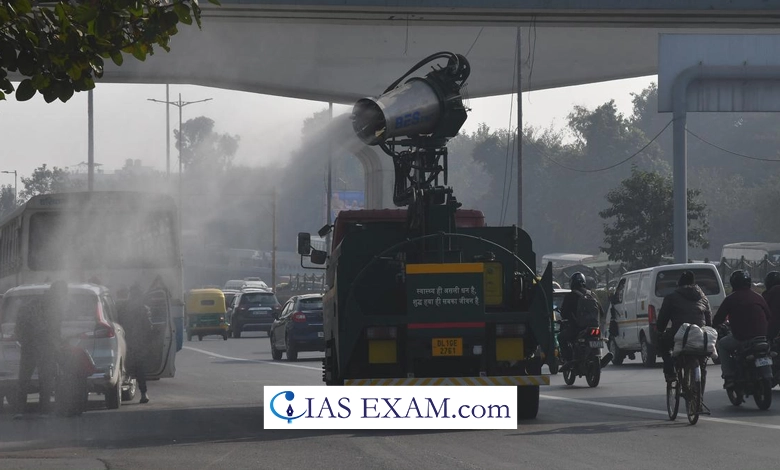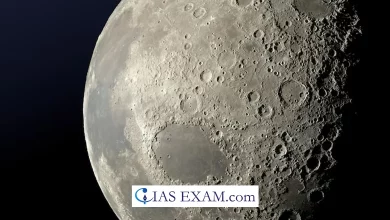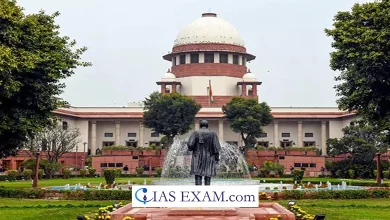Daily Current Affairs for UPSC
Revised targets under National Clean Air Programme
Syllabus- Environment [GS Paper-3]

Context
As per the initial targets of National Clean Air Programme (NCAP) 2019, India was to cut the concentration of atmospheric Particulate Matter (PM) by 20-30% by 2024, from 2017 levels. This was later revised to 40% by 2026.
National Clean Air Programme
-
- NCAP was launched in January 2019 to improve air quality through a city specific action plan.
- Under NCAP, cities regularly violating annual PM stages in India need to prepare and enforce annual Clean Air Action Plans (CAAPs).
- Objectives
-
-
- Stringently implementing mitigation measures to prevent, control, and impede air pollution
- Strengthening an air quality monitoring network across the country.
- Increasing public consciousness and potential constructing measures
-
- Funding
-
- The Ministry of Environment, Forest, & Climate Change has allocated ₹10,422.73 crore.
Performance of NCAP
- Air Information Centers and Pollution Forecasting
-
-
- NCAP aimed to establish air information centres at central and regional levels by 2020.
- However, as of December 2023, only the crucial ‘Portal for Regulation of Air Pollution in Non-Attainment Cities (PRANA)’ portal by the Central Pollution Control Board (CPCB) is useful.
- Despite NCAP’s intention for air pollutants forecasting systems in non-attainment cities by 2022, only Delhi has a functional system by December 2023.
-
- Committee Setup and Utilization of Funds
-
-
- Committees at various levels had been proposed by NCAP, but their capability, transparency, and public availability of facts continue to be challenging.
- Out of overall allocations of 1253 crore to 82 non-attainment cities, simplest 498 crores (40%) was applied till November 2023.
- The trend reflects huge underutilization of the allotted price range.
-
- Monitoring Stations and Continuous Ambient Air Quality Monitoring Stations:
-
- NCAP envisaged augmenting the manual tracking stations below the National Air Quality Monitoring Programme (NAMP) from the existing 703 stations to 1,500 stations by 2024.
- However, as of December 2023, only 931 manual stations have been operational, with a minimum increase from the preceding year, showing a crucial shortfall towards the goal.
- NCAP aimed for 150 Continuous Ambient Air Quality Monitoring Stations (CAAQMS), but 531 stations are currently operational, indicating progress.
- The rural monitoring network includes 26 guide stations covering limited areas.
- Efforts to install 100 monitoring stations by 2024 in rural regions are yet to be realized and appear difficult to implement.
Challenges faced by NCAP
- Implementation by States has been inconsistent
-
-
- Most cities proactively submitted their CAAPs yet their implementation has been inconsistent.
- Implementation delays prevent NCAP’s achievement
-
- Lack of standard operating procedures for the implementation process
-
-
- Time-ingesting tasks required to put into effect control measures and the absence of rightly-defined timelines create delays.
-
- Other Challenges
-
- Bureaucratic red-tapism and lingering doubts concerning the effectiveness of proposed mitigation measures.
Way ahead
- Emissions Inventory (EI)and Source Apportionment (SA) studies are critical.
-
-
- EI and SA research are critical to discover and recognize the origins of pollution.
- EIs offer insights into local pollutants sources and their contributions. EIs also assist form centered pollution control strategies.
- SA research offers an in-depth analysis of contributions from diverse pollution sources, along with the ones positioned afar.
-
- Important position of Air Quality (AQ) model
-
- EIs and SA research have limitations.
- EIs have boundaries in assessing the impact of transboundary pollution assets — along with when figuring out the effect of stubble-burning outdoor Delhi on the city’s air quality.
Conclusion
- The adventure closer to purifier air in India, as charted by NCAP, will be difficult however is essential.
- NCAP’s success hinges on a multifaceted method that combines rigorous medical research, strategic budget, and fast and effective implementation of mitigation measures.
Source:The Hindu
UPSC Mains Practice Question
Q.Describe the key points of the revised Global Air Quality Guidelines (AQGs) recently released by the World Health Organisation (WHO). How are these different from its last update in 2005? What changes in India’s National Clean Air Programme are required to achieve revised standards? (2021)





.png)



